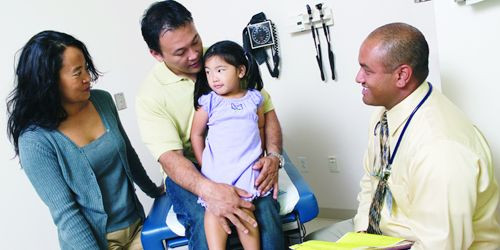Doctors Push to Lower Pain and Stress in Emergency Rooms for Kids

Going to the emergency room often means a child is in pain and extremely anxious, which is why the American Academy of Pediatrics has issued a new report emphasizing the importance of reducing pain and stress in children in emergency rooms.
"There are a lot of modalities for reducing pain in children, and we're doing a lot better in terms of kids' pain than we used to," said report author Dr. Joel Fein, an emergency room doctor at the Children's Hospital of Philadelphia and professor of pediatrics and emergency medicine at the University of Pennsylvania School of Medicine, according to HealthDay.
"Parents should advocate for the children for pain and anxiety management" if they feel like their kids aren't getting sufficient treatment, Fein added.
Researchers who wrote the latest report, published Oct.29 in the November print issue of the journal Pediatrics reviewed nearly 250 medical studies and found that there were many potential barriers to achieving a pain-free emergency room visit. For example, the complexity of assessment, difficulties in communication, lack of staff, and medication concerns, like adverse effects, are all barriers for treating pain in the emergency room.
Medication concern is a big concern in treating pain because of the fear of side effects and because doctors fear that giving medications to mask the pain might affect treatment because it could make it more difficult or time-consuming to make a diagnosis.
Researchers reported that doctors sometimes even skip out on topical anesthetics when they believe that they might delay the right diagnosis. They added that topical anesthetics also aren't readily available in all emergency rooms.
The team said that narcotic medications still carry a stigma, and doctors typically are less likely to use these drugs in children. Furthermore, the report says that there is still a racial bias in the prescription of narcotic drugs, with black children less likely to receive them for pain relief.
Researchers suggest that these obstacles in treating pain can be overcome and that medics should begin administering pain relief even before the child reaches the hospital if they are coming in an ambulance.
Researchers said that once the child is at the hospital it is important to keep the child calm because increased stress and anxiety leads to a greater perception of pain. The team recommends that families be given a private room with colorful walls, picture on the ceilings and a collection of toys or games to keep the child occupied and distracted.
They also recommended the use of medications like acetaminophen, ibuprofen or oral narcotics as well as topical anesthetics to numb areas before inserting IV catheters, adding that children are usually very afraid of needles and topic anesthesia can offer pain relief during IV line placement and drawing blood.
Researchers said that letting a family member stay close to the child also has a calming effect.
"Although there is no evidence that family presence decreases pain, their presence for procedures can decrease child distress," Fein and colleagues wrote in their report.
While pain management in adults has improved significantly over the years, Fein said that pain relief in children, particularly babies, lags far behind, and this is worrying because pain can have lasting effects on a child's perception of medical care.
"When kids are subjected to emotional distress due to painful procedures, there's evidence to suggest they can have lasting emotional scarring," said Dr. Michael Kim, chief of pediatric emergency medicine at the University of Wisconsin School of Medicine and Public Health, who was not involved with the new study, according to ABC News. "That's why kids are scared of doctors. ... This could cause problems in seeking healthcare."
Experts say that while this report mainly provides guidance for doctor and nurses, it can also be helpful for parents.
"Parents are the best advocates for their children," Dr. Baruch Krauss, an associate professor of pediatrics at Harvard Medical School, who was not involved with the study, told ABC News. "They can tell when their child is anxious or in pain."
"By raising awareness of the resources available, it helps parents know what to do and what to ask for," he added.



























